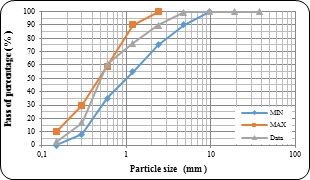Effects of Corn Stalks Ash as A Substitution Material of Cement Due to the Concrete Strength of Rigid Pavement
DOI:
https://doi.org/10.25299/jgeet.2022.7.1.4681Keywords:
Compressive Strength, Flexural Strength, Optimum Content, Rigid Pavement, Cement SubstitutionAbstract
Cement is an adhesive material for concrete mixtures in addition to water, fine and coarse aggregates. One of the main ingredients of cement is silica (SiO2) which is originated from the earth's crust. Silica is also available in plants such as corn stalks. This research is aimed to utilize the corn stalk ash (CSA) as an alternative substitution for some cement in concrete for the rigid pavement of road construction. According to the Indonesian standard, the flexural tensile strength should be exceeded at least 4.5 MPa. The flexural tensile strength has also a correlation due to compressive strength.
The concrete materials consisted of the coarse aggregate (river crushed stone) from Kampar River and Danau Bingkuang sands from Kampar District of Riau Province, and Portland Composite Cement from Semen Padang. The CSA was made by burning the dried corn stalks in a steel cylinder can over 24 hours. The content of CSA was varied by 0%, 5%, 7% and 9%. The compressive strength design of concrete was 31,3 MPa. Testing procedures were based on the Indonesian Standard for concrete. The tested specimens have consisted of cube specimens (150 mm x 150 mm x 150 mm) for compressive tests, and beam specimens (150 mm x 150 mm x 600 mm) for flexural strength tests. All specimens were tested on 28 days-age.
The results show that CSA can be used as a partial substitution of cement in concrete. The addition of CSA tends to increase the compressive strength of concrete instead of its flexural tensile strength. The optimum content of CSA was 7% and resulted in an 8.0% and 6.9% increase in compressive and flexural tensile strength due to design respectively. Compressive and flexural tensile strength fulfilled the standard. Flexural tensile strength is obtained by 15% of the compressive strength. Cornstalk ash can be used as a substitution of cement for rigid pavement concrete. It can reduce the utilization of cement and will be potentially cost efficiency.
Downloads
References
ACI 318-89, 1990. (1990). Building Code Requirements for Reinforce Concrete, Part I, General Requirement, Fitth Edition. Skokie, Illinois, USA: PCA.
Badan Standardisasi Nasional. (1990). SNI 03-1974-1990 Metode Pengujian Kuat Tekan Beton. SNI 03-1974-1990.
Dipohusodo, I. (1999). Struktur Beton Bertulang Berdasarkan SK SNI T- 15-1991-03. Jakarta: PT. Gramedia Pustaka Utama.
Ervina. (2013). Isolasi Silika Dari Tongkol Jagung, Tugas akhir, Universitas Pembangunan Nasional, Surabaya.
Et.al, B. (1980). Food Comotition and Analysis, p.122-123,AVI Publishing, New York.
Majedu, K. A., S. A. A. and I. O. L. (2014). The Use of Corn Cob Ash and Saw Dust Ash as Cement Replacement in Concrete Works. The Internasional Journal of Engineering and Science (IJES) Vol. 3 No. 4. Federal Polytechnic Ede : Osun State.
Mulyono, T. (n.d.). Teknologi Beton, Edisi Kedua, Andi, Yogyakarta. 2004.
Nugraha, A. dan P. (2007). Teknologi Beton. Penerbit C.V Andi Offset, Yogyakarta.
Pd T-07-2005-B. (2005). Pelaksanaan pekerjaan beton untuk jalan dan jembatan. Badan Penelitian Dan Pengembangan PUPR, 1–21.
Sukirman, S. 2003. (2013). Persyaratan Beton Struktural untuk Bangunan Gedung. In Bandung: Badan Standardisasi Indonesia.
SNI 4431-2011, S. (2011). Cara Uji Kuat Lentur Beton Normal dengan Dua Titik Pembebanan.
Tata Cara Perhitungan Struktur Beton Untuk Bangunan Gedung. SNI 03-2847-2002. (2002). SNI 03-2847-2002, 251.
Tenriajeng. (1999). Perkerasan Kaku Jalan Raya 2013–2015.
Yuwono, R. dan. (2001). Kesuburan dan pemupukan tanah pertanian”, Pustaka Buana, Bandung.

Downloads
Published
Issue
Section
License
Copyright @2019. This is an open-access article distributed under the terms of the Creative Commons Attribution-ShareAlike 4.0 International License which permits unrestricted use, distribution, and reproduction in any medium. Copyrights of all materials published in JGEET are freely available without charge to users or / institution. Users are allowed to read, download, copy, distribute, search, or link to full-text articles in this journal without asking by giving appropriate credit, provide a link to the license, and indicate if changes were made. All of the remix, transform, or build upon the material must distribute the contributions under the same license as the original.










